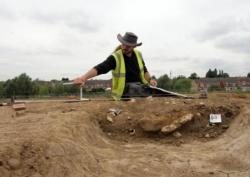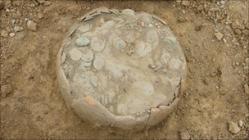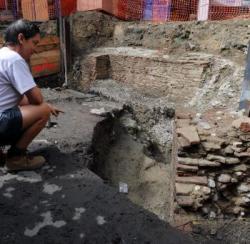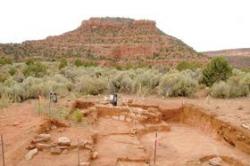- 28 JUILLET
- INDI-UNI : 
PRE-INSCRIPTION : 15 Juin – 15 Août
PRE-REGISTRATION: June 15th - August 15th
- USA – Madison County - Some young Native Americans are digging into their shared past while taking part in an archaeological project at the site of a once-thriving Oneida Indian village that stood on a New York hilltop more than four centuries ago. They're spending six weeks digging at an Oneida-owned wooded site amid the rolling farmland of Madison County, a few miles south of the tribe's reservation in central New York. Jesse Bergevin, the Oneida Nation's historical resources specialist and field archaeologist overseeing the project, said Wednesday that the village was home to the Oneidas' main community in the mid- to late-16th century. Bergevin said they hope to uncover evidence of some of the many longhouses that housed about 1,500 Oneidas believed to have lived on the hilltop, along with remnants of the log palisades that typically surrounded an Iroquois village. The Oneidas were part of the Iroquois Confederacy spread between the Hudson River and Lake Erie. The tribe was concentrated in an area encompassing today's neighboring Oneida and Madison counties, 75 miles west of Albany. Bergevin said the Oneida village in what became Smithfield was occupied for about 25 years until around 1575, when they relocated to a nearby site after extensive cultivation depleted the soil.
http://online.wsj.com/article/AP17aeb65b6334498a9305eaf5a4dca688.html
- ROYAUME UNI –  Burton Latimer - An ancient Roman village dating back almost 2,000 years has been uncovered in the north of the county. The farmstead was unearthed in Higham Road, Burton Latimer, and archaeologists believe it would have been fully functional in the second century AD. Artefacts including coins and jars have been found at the site and the skeletons of 30 Romans were excavated from the settlement’s cemetery. Simon Mortimer, director of CGMS Consulting, the company in charge of the dig, said: “In 1954 someone found some Roman coins here so we knew there would be something here. “The ironwork and bronzework we’ve found suggests these were wealthy people living here – we are certainly not talking about peasants. “This would have been a sophisticated society and that shows because we’ve found some pottery imported from France. More than 40kg of pottery was found at the site, along with bronze work including a foot thought to be from a statuette of a Roman god. The oldest artefacts found on the site actually come from long before the Romans settled – neolithic flint spears thought to be about 4,000 years old. They would have been used by people for hunting. Mr Mortimer said: “It’s bizarre to think that there was more time between the neolithic period and the Romans than there was between the Romans and us.”
Burton Latimer - An ancient Roman village dating back almost 2,000 years has been uncovered in the north of the county. The farmstead was unearthed in Higham Road, Burton Latimer, and archaeologists believe it would have been fully functional in the second century AD. Artefacts including coins and jars have been found at the site and the skeletons of 30 Romans were excavated from the settlement’s cemetery. Simon Mortimer, director of CGMS Consulting, the company in charge of the dig, said: “In 1954 someone found some Roman coins here so we knew there would be something here. “The ironwork and bronzework we’ve found suggests these were wealthy people living here – we are certainly not talking about peasants. “This would have been a sophisticated society and that shows because we’ve found some pottery imported from France. More than 40kg of pottery was found at the site, along with bronze work including a foot thought to be from a statuette of a Roman god. The oldest artefacts found on the site actually come from long before the Romans settled – neolithic flint spears thought to be about 4,000 years old. They would have been used by people for hunting. Mr Mortimer said: “It’s bizarre to think that there was more time between the neolithic period and the Romans than there was between the Romans and us.”
http://www.northantset.co.uk/news/local/corby/ancient_artefacts_unearthed_at_site_1_2903595
- ROYAUME UNI –  Montgomery - More than 3,000 Roman coins have been discovered in a field, it has emerged. The hoard of copper alloy coins, dating from the 3rd Century, was unearthed in Montgomery, Powys, several weeks ago. About 900 were found by a member of a Welshpool metal detecting club, with the rest of the discovery made with help from archaeologists. The exact location is being kept secret to protect the site. Clwyd-Powys Archaeological Trust (CPAT), which helped unearth the coins, said the discovery had the potential to reveal more about Roman life in mid Wales in the late 3rd Century. The find in Montgomery is a few miles away from where a Roman fort once stood in the village of Forden. The majority of the coins were found buried in a ceramic pot, said the trust. "This was probably a time of considerable political and economic unrest and the coins may have been buried for safekeeping with the intention of returning for them in the future. "Unfortunately for the original owner, but happily for us, for some reason they never had the chance to recover them."
Montgomery - More than 3,000 Roman coins have been discovered in a field, it has emerged. The hoard of copper alloy coins, dating from the 3rd Century, was unearthed in Montgomery, Powys, several weeks ago. About 900 were found by a member of a Welshpool metal detecting club, with the rest of the discovery made with help from archaeologists. The exact location is being kept secret to protect the site. Clwyd-Powys Archaeological Trust (CPAT), which helped unearth the coins, said the discovery had the potential to reveal more about Roman life in mid Wales in the late 3rd Century. The find in Montgomery is a few miles away from where a Roman fort once stood in the village of Forden. The majority of the coins were found buried in a ceramic pot, said the trust. "This was probably a time of considerable political and economic unrest and the coins may have been buried for safekeeping with the intention of returning for them in the future. "Unfortunately for the original owner, but happily for us, for some reason they never had the chance to recover them."
http://www.bbc.co.uk/news/uk-wales-mid-wales-14307381
- FRANCE -  Toulouse - Une vingtaine de pièces de monnaie romaines, des bouts de verre coloré, des épingles à cheveux en os, des fragments de poteries, un morceau de céramique antique travaillée avec des décors, un « fusaïole » (anneau percé qui servait de plomb aux fuseaux pour filer la laine) en parfait état et joliment décoré… Ces objets étaient enfouis à plusieurs mètres de profondeur sous le square Charles-de-Gaulle. En creusant le sol sur quelques mètres carrés, à l'endroit où sera aménagée l'issue de secours de la station Capitole, les archéologues de l'INRAP ont découvert un morceau de mur de brique d'époque médiévale qui leur semble être un bout de façade de la maison commune, l'ancêtre du Capitole, mais surtout des vestiges de bâtiments au sol en terre battue, datant de l'époque romaine, entre le Ier siècle et le IVe siècle après Jésus-Christ, période où la vie s'organise dans la nouvelle ville. « C'est une petite fenêtre sur l'organisation de la ville antique. On est ici intra-muros, à 30 mètres des remparts et 100 mètres de la voie principale qui conduisait de la porte narbonnaise à la place du Capitole » explique Pascal Lotti. « On a eu la chance de travailler sous une rue créée à l'époque médiévale et d'avoir accès à une succession de couches archéologiques couvrant 3 ou 4 siècles, ce qui est assez rare au centre ville » poursuit l'archéologue. Pour le néophyte, ces morceaux de murailles n'évoquent pas grand-chose. Mais les archéologues parlent d'une « très bonne surprise ». Selon eux ces vestiges « préservés de façon remarquable » apporteront d'autres éléments de compréhension sur la genèse de la ville à cette période, bien antérieure à l'arrivée des Wisigoths qui régneront sur Toulouse à partir du Ve siècle. Les archéologues vont encore pouvoir explorer ce petit périmètre pendant deux semaines et demie.
Toulouse - Une vingtaine de pièces de monnaie romaines, des bouts de verre coloré, des épingles à cheveux en os, des fragments de poteries, un morceau de céramique antique travaillée avec des décors, un « fusaïole » (anneau percé qui servait de plomb aux fuseaux pour filer la laine) en parfait état et joliment décoré… Ces objets étaient enfouis à plusieurs mètres de profondeur sous le square Charles-de-Gaulle. En creusant le sol sur quelques mètres carrés, à l'endroit où sera aménagée l'issue de secours de la station Capitole, les archéologues de l'INRAP ont découvert un morceau de mur de brique d'époque médiévale qui leur semble être un bout de façade de la maison commune, l'ancêtre du Capitole, mais surtout des vestiges de bâtiments au sol en terre battue, datant de l'époque romaine, entre le Ier siècle et le IVe siècle après Jésus-Christ, période où la vie s'organise dans la nouvelle ville. « C'est une petite fenêtre sur l'organisation de la ville antique. On est ici intra-muros, à 30 mètres des remparts et 100 mètres de la voie principale qui conduisait de la porte narbonnaise à la place du Capitole » explique Pascal Lotti. « On a eu la chance de travailler sous une rue créée à l'époque médiévale et d'avoir accès à une succession de couches archéologiques couvrant 3 ou 4 siècles, ce qui est assez rare au centre ville » poursuit l'archéologue. Pour le néophyte, ces morceaux de murailles n'évoquent pas grand-chose. Mais les archéologues parlent d'une « très bonne surprise ». Selon eux ces vestiges « préservés de façon remarquable » apporteront d'autres éléments de compréhension sur la genèse de la ville à cette période, bien antérieure à l'arrivée des Wisigoths qui régneront sur Toulouse à partir du Ve siècle. Les archéologues vont encore pouvoir explorer ce petit périmètre pendant deux semaines et demie.
http://www.ladepeche.fr/article/2011/07/28/1136090-nouvelles-decouvertes-sous-le-square-du-capitole.html
- FRANCE – Bordeaux - A l'occasion du réaménagement de l’espace Saint-Michel d’ici 2013, entre le marché des Capucins et le quai des Salinières, des fouilles d’archéologie préventive se déroulent dans le quartier du 7 juin au 9 septembre. Les travaux peu profonds pourront atteindre par endroit des vestiges archéologiques, médiévaux, gallo-romains, voire plus anciens. L’opération d’archéologie préventive se déroulera en 3 phases planifiées, inscrites dans le déroulement du chantier. La première, du 7 au 29 juin, concernait six sondages d’observation destinés à répondre à certaines questions : où sont vraiment localisés les vestiges ? De quoi s’agit-il ? A quelle profondeur et dans quel état de conservation sont-ils... Déjà, un ancien habitat, d'anciennes caves d'habitation et un cimetière médiéval ont déjà été repérés. La seconde phase du 11 juillet au 9 septembre 2011, est consacrée à la fouille archéologique de trois secteurs où les vestiges les plus significatifs ont été repérés. Cette phase peut être prolongée d'un mois supplémentaire en cas de découvertes majeures. Une habitation du XVe siècle ainsi qu'un sarcophage datant du XIIIe - XIVe siècle ont déjà été mis à jour. Enfin, la troisième phase accompagnera les travaux d’aménagement et complétera éventuellement les observations scientifiques des phases 1 et 2.
http://www.bordeaux.fr/ebx/portals/ebx.portal?_nfpb=true&_pageLabel=pgFicheEvt&classofcontent=evenement&id=65873
- TURQUIE – Stratonikeia - Archaeologists unearthed a 2,000-year-old arena used for gladiator games in Muğla's Yatağan district, once the site of the ancient city Stratonikeia. Dr. Bilal Söğüt, a professor in the department of archaeology of Pamukkale University and the head of the excavation, said, “We know gladiators lived in this time period, and we know their graves are here.” Dr. Söğüt said they first unearthed the blocks of the racing arena in 2009, when they were studying the city's northern gate. “Finding the arena was a very important development,” Söğüt said. “We will be able to learn details such as what harnesses were like.”
http://www.todayszaman.com/news-251820-3500-year-old-ancient-treasure-unearthed-in-turkey.html
- USA –  Kanab - The Center for Education, Business and Arts (CEBA) presents the Kanab Archaeology Community Symposium, a free program, on August 10. Archeologists have worked intently, digging, sifting and brushing the land, looking for clues about how these ancient people lived. They are dedicated to bringing the past back into the future through education, exploration, and preservation. Now they are bringing their data recovery to you in two power point presentations. The first one is the “Jackson Flat Reservoir Project” by Heidi Roberts, principal of HRA Conservation and Archaeology and the second one is “Kanab Creek and Beyond” by Barbra W. Frank, co-director of SUU Field School.
Kanab - The Center for Education, Business and Arts (CEBA) presents the Kanab Archaeology Community Symposium, a free program, on August 10. Archeologists have worked intently, digging, sifting and brushing the land, looking for clues about how these ancient people lived. They are dedicated to bringing the past back into the future through education, exploration, and preservation. Now they are bringing their data recovery to you in two power point presentations. The first one is the “Jackson Flat Reservoir Project” by Heidi Roberts, principal of HRA Conservation and Archaeology and the second one is “Kanab Creek and Beyond” by Barbra W. Frank, co-director of SUU Field School.
http://www.sunews.net/article.cfm?articleID=898
- CANADA – Dresden - Starting tomorrow, archaeologists from The University of Western Ontario and the Ontario Heritage Trust will begin to search for unmarked graves at Uncle Tom’s Cabin Historic Site in Dresden. The site is home to two historic cemeteries belonging to the British American Institute and the Henson family. Although many tombstones are visible at the two cemeteries, their positions do not always precisely mark the location of the underlying graves. The team will use Ground Penetrating Radar (GPR). GPR sends radar waves into the ground that are reflected back off buried features and objects allowing archaeologists to map their position. The work is set to take place July 28 and 29, just prior to Emancipation Day, August 1, which marks the 177th anniversary of the abolition of slavery in the British colonies (August 1, 1834). Josiah Henson (1789-1883) was born into slavery in Charles County, Maryland. He escaped to Canada in 1830 after 41 years working as a slave, and was one of the founders of a settlement and laborer's school for other fugitive slaves at Dresden, Ontario, called the Dawn Settlement in 1842. Through his leadership, the British American Institute, one of Canada's first industrial schools, was founded. The school was intended for the advancement of fugitive slaves. Josiah Henson's name became synonymous with the central character "Uncle Tom" in Harriet Beecher Stowe's famous novel Uncle Tom's Cabin (1852).
http://www.exchangemagazine.com/morningpost/2011/week30/Thursday/072804.htm